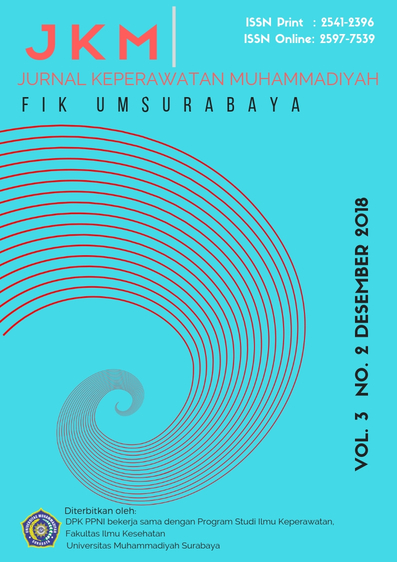Efektifitas Metode Pembelajaran Klinik Terhadap Kemampuan Berpikir Kritis Dan Kepercayaan Diri Mahasiswa Keperawatan : A Literature Review
DOI:
https://doi.org/10.30651/jkm.v3i2.1823Keywords:
clinical learning method, nursing students, critical thinking, self confidenceAbstract
Background : Critical thinking of nursing students have to be increased considering the importance of these things in making decisions, problem solving and clinical judgment and supported by self confidence. Although critical thinking and self confidence are important, but all of students are not able to do that. For this reason, clinical instructor have to make innovation through learning methods to achieve this. The purpose of this literature review is to identify the clinical learning method affecting the critical thinking and self confidence of nursing students.
Method: Â Â the data base used in making this review of literature are Pubmed, Science Direct, and Google Scholar published in 2007-2018.
Result: Â From the 12 articles used in this literature review, it was found that in order to improve the critical thinking and self confidence of nursing students in a clinical environment, the clinical supervisor can use student-centered learning methods and can even involve patients. The learning methods include simulation, nursing round method, demonstration models, clinical conference, and concept mappimg.
Conclusion :Â Â the learning method affected the critical thinking and self confidence of nursing students including clinical conference, simulations, demonstration models, concept mapping and nursing rounds. Therefore the supervisor must be able to know and choose what method is appropriate for clinical guidance. Â
References
DAFTAR PUSTAKA
Adegbola, M. (2011). Taking Learning To The Learner : Using Audio Teleconferencing For Post-Clinical Conferences. Creative Nursing, 17(3), 120–125.
Billings, D. M., & Halstead, J. A. (2016). Teaching In Nursing : A guide for Faculty (5th ed.). Missouri: Elsevier.
Carlos, J., Martins, A., Carlos, R., Baptista, N., Rita, V., Coutinho, D., … Mendes, C. (2014). Self-confidence for emergency intervention : adaptation and cultural validation of the Self-confidence Scale in nursing students, 22(4), 554–561. https://doi.org/10.1590/0104-1169.3128.2451
Delunas, L., & Rooda, L. (2009). A new model for the clinical instruction of undergraduate nursing students. Nursing Education Perspective, 30(6), 377–370.
Distler, J. W. (2007). Critical thinking and clinical competence : Results of the implementation of student-centered teaching strategies in an advanced practice nurse curriculum. Nurse Education in Practice, 7, 53–59. https://doi.org/10.1016/j.nepr.2006.08.003
EL-Hay, S. A. A., Mezayen, S. E. El, & Ahmed, R. E. (2018). Effect of concept mapping on problem solving skills , competence in clinical setting and knowledge among undergraduate nursing students. Journal of Nursing Education and Practice, 8(8), 34–46. https://doi.org/10.5430/jnep.v8n8p34
Gaberson, K. B., & Oermann, M. H. (2010). Clinical Teaching Stategies in Nursing (3rd ed.). New York: Springer Publishing Company.
Hsu, L. (2007). Conducting clinical post-conference in clinical teaching : a qualitative study. Journal of Cilinical Nursing, 1525–1533. https://doi.org/10.1111/j.1365-2702.2006.01751.x
Huang, Y., Chen, H., Yeh, M., & Chung, Y. (2012). Case studies combined with or without concept maps improve critical thinking in hospital-based nurses : A randomized-controlled trial. International Journal of Nursing Studies, 49(6), 747–754. https://doi.org/10.1016/j.ijnurstu.2012.01.008
Kimhi, E., Reisthein, J. L., Cohen, M., Friger, M., Hurvitz, N., & Avraham, R. (2016). Impact of Simulation and Clinical Experience on Self-efficacy in Nursing Students. Nurse Educator, 41(1), 4–7. https://doi.org/10.1097/NNE.0000000000000194
Kumm, S., Godfrey, N., Richards, V., Hulen, J., & Ray, K. (2016). Nurse Education Today Senior student nurse pro fi ciency : A comparative study of two clinical immersion models, 44, 146–150.
L, G., MS, G., K, C., CA, G., K, K., & Neal-T, D. (2013). Effect of Simulation on the Development of Critical Thinking in Associate Degree Nursing Students. Nurse Education Perspectives, 34(3), 159–162.
Ludenberg, C. A., & Kim, Y. K. (2016). A Structural Model of the Relationship Between Student–Faculty Interaction and Cognitive Skills Development Among College Students. American Educational Research Association, 57(3), 288–309.
Mann, J. W. (2012). Promoting Curriculum Choices : Critical Thinking and Clinical Judgment Skill Development In Baccalaureate Nursing Students. Kansas Nurse, 87(1).
Mc Cabe, D. E., Gilmartin, M. J., & Goldsamt, L. A. (2016). Student Self-confidence with Clinical Nursing Competencies in A High-dose Simulation Clinical Teaching Model. Journal of Nursing Education and Practice, 6(8), 52–58. https://doi.org/10.5430/jnep.v6n8p52
Moattari, M., Soleimani, S., & Mehbodi, F. (2014). Clinical concept mapping : Does it improve discipline-based critical thinking of nursing students ? Iranian Journal of Nursing and Midwifery Research, 19(1), 70–76.
Murray, T. A., Crain, C., Meyer, G. A., Mcdonough, M. E., & Schweiss, D. M. (2010). Building bridges: An innovative academic-service partnership. Nursing Outlook, 58(5), 252–260. https://doi.org/10.1016/j.outlook.2010.07.004
Niederhauser, V., Schoessler, M., Gubrud-Howe, P. M., Magnussen, L., & Codier, E. (2012). Creating Innovative Models of Clinical Nursing Education. Journal of Nursing Education, 51(11), 603–608.
Nursalam, & Efendi, F. (2008). Pendidikan dalam Keperawatan. Jakarta: Salemba Medika.
Purvis, C. A. (2009). Factors That Influence The Development of Critical Thinking Skills In Associate Degree Nursing Students. Proquest Dissertations.
Scronce, C. N. (2013). Clinical conferences in nursing education. Duke University School of Nursing.
Shea, P., & Bidjerano, T. (2009). Community of Inquiry as a theoretical framework to foster “epistemic engagement†and “cognitive presence†in online education. Computers & Education., 52, 543–553.
Sherrill, K. J. (2012). Using nursing grand rounds to enforce Quality and Safety Education for Nurses competencies. Teaching and Learning in Nursing, 7(3), 118–120. https://doi.org/10.1016/j.teln.2011.11.007
Shin, K., Jung, D., Shin, S., & Kim, M. (2006). Critical thinking dispositions and skills of senior nursing students in associate, baccalaureate, and RN-to-BSN programs. Nursing Education, 45, 233–237.
Syahreni, E., & Waluyanti, F. T. (2007). Pengalaman Mahasiswa S1 Keperawatan Program Reguler Dalam Pembelajaran Klinik. Jurnal Keperawatan Indonesia, 11(2), 47–53.
Weaver, A. (2015). The Effect of a Model Demonstration During Debriefing on Students ’ Clinical Judgment , Self- confidence , and Satisfaction During a Simulated Learning Experience. Clinical Simulation in Nursing, 11(1), 20–26. https://doi.org/10.1016/j.ecns.2014.10.009
Wheeler, L., & Collins, S. (2003). The influence of concept mapping on critical thinking in baccalaureate nursing students. Journal of Professional Nursing, 19, 339–346.
Downloads
Published
Issue
Section
License
- Penulis tetap memegang hak atas karyanya dan memberikan hak publikasi pertama kepada jurnal ini yang secara simultan karya tersebut dilisensikan di bawah:Â Creative Commons Attribution-ShareAlike 4.0 International (CC BY-SA 4.0)













